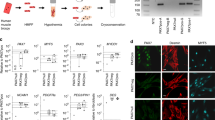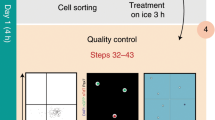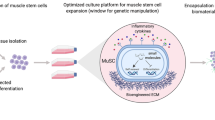Abstract
Muscle-derived stem cells (MDSCs) can differentiate into multiple lineages, including haematopoietic lineages1,2,3,4,5,6,7,8,9,10,11,12. However, it is unknown whether MDSCs preserve their myogenic potential after differentiation into other lineages. To address this issue, we isolated from dystrophic muscle a population of MDSCs that express stem-cell markers and can differentiate into various lineages1,13. After systemic delivery of three MDSC clones into lethally irradiated mice, we found that differentiation of the donor cells into various lineages of the haematopoietic system resulted in repopulation of the recipients' bone marrow. Donor-derived bone-marrow cells, isolated from these recipients by fluorescence-activated cell sorting (FACS), also repopulated the bone marrow of secondary, lethally irradiated, recipients and differentiated into myogenic cells both in vitro and in vivo in normal mdx mice. These findings demonstrate that MDSC clones retain their myogenic potential after haematopoietic differentiation.
This is a preview of subscription content, access via your institution
Access options
Subscribe to this journal
Receive 12 print issues and online access
$209.00 per year
only $17.42 per issue
Buy this article
- Purchase on Springer Link
- Instant access to full article PDF
Prices may be subject to local taxes which are calculated during checkout



Similar content being viewed by others
References
Lee, J.Y. et al. Clonal isolation of muscle-derived cells capable of enhancing muscle regeneration and bone healing. J. Cell Biol. 150, 1085–1100 (2000).
Gussoni, E. et al. Dystrophin expression in the mdx mouse restored by stem cell transplantation. Nature 401, 390–394 (1999).
Seale, P., Asakura, A. & Rudnicki, M.A. The potential of muscle stem cells. Dev. Cell 1, 333–342 (2001).
Goodell, M.A. et al. Stem cell plasticity in muscle and bone marrow. Ann. NY Acad. Sci. 938, 208–220 (2001).
Jackson, K.A., Mi, T. & Goodell, M.A. Hematopoietic potential of stem cells isolated from murine skeletal muscle. Proc. Natl Acad. Sci. USA 96, 14482–14486 (1999).
McKinney-Freeman, S.L. et al. Muscle-derived hematopoietic stem cells are hematopoietic in origin. Proc. Natl Acad. Sci. USA 99, 1341–1346 (2002).
Blau, H.M., Brazelton, T.R. & Weimann, J.M. The evolving concept of a stem cell: entity or function? Cell 105, 829–841 (2001).
Torrente, Y. et al. Intraarterial injection of muscle-derived CD34(+)Sca-1(+) stem cells restores dystrophin in mdx mice. J. Cell Biol. 152, 335–348 (2001).
Kawada, H. & Ogawa, M. Bone marrow origin of hematopoietic progenitors and stem cells in murine muscle. Blood 98, 2008–2013 (2001).
Jackson, K.A., Majka, S.M., Wulf, G.G. & Goodell, M.A. Stem cells: a minireview. J. Cell Biochem. Suppl. 38, 1–6 (2002).
Goldring, K., Partridge, T. & Watt, D. Muscle stem cells. J. Pathol. 197, 457–467 (2002).
Jiang, Y. et al. Multipotent progenitor cells can be isolated from postnatal murine bone marrow, muscle, and brain. Exp. Hematol. 30, 896–904 (2002).
Qu-Petersen, Z. et al. Identification of a novel population of muscle stem cells in mice: potential for muscle regeneration. J. Cell Biol. 157, 851–864 (2002).
Qu, Z. et al. Development of approaches to improve cell survival in myoblast transfer therapy. J. Cell Biol. 142, 1257–1267 (1998).
Rando, T.A. & Blau, H.M. Primary mouse myoblast purification, characterization, and transplantation for cell-mediated gene therapy. J. Cell Biol. 125, 1275–1287 (1994).
Richler, C. & Yaffe, D. The in vitro cultivation and differentiation capacities of myogenic cell lines. Dev. Biol. 23, 1–22 (1970).
Hoffman, E.P., Brown, R.H., Jr & Kunkel, L.M. Dystrophin: the protein product of the Duchenne muscular dystrophy locus. Cell 51, 919–928 (1987).
Lewis, J.L. et al. The influence of INK4 proteins on growth and self-renewal kinetics of hematopoietic progenitor cells. Blood 97, 2604–2610 (2001).
Terada, N. et al. Bone marrow cells adopt the phenotype of other cells by spontaneous cell fusion. Nature 416, 542–545 (2002).
Ying, Q.L., Nichols, J., Evans, E.P. & Smith, A.G. Changing potency by spontaneous fusion. Nature 416, 545–548 (2002).
Goepfert, T.M. et al. Progesterone facilitates chromosome instability (aneuploidy) in p53 null normal mammary epithelial cells. FASEB J. 14, 2221–2229 (2000).
Kubota, C. et al. Six cloned calves produced from adult fibroblast cells after long-term culture. Proc. Natl Acad. Sci. USA 97, 990–995 (2000).
Wagers, A.J., Sherwood, R.I., Christensen, J.L. & Weissman, I.L. Little evidence for developmental plasticity of adult hematopoietic stem cells. Science 297, 2256–2259 (2002).
Bittner, R.E. et al. Recruitment of bone-marrow-derived cells by skeletal and cardiac muscle in adult dystrophic mdx mice. Anat. Embryol. (Berl.) 199, 391–396 (1999).
Ferrari, G. et al. Muscle regeneration by bone marrow-derived myogenic progenitors. Science 279, 1528–1530 (1998).
LaBarge, M.A. & Blau, H.M. Biological progression from adult bone marrow to mononucleate muscle stem cell to multinucleate muscle fiber in response to injury. Cell 111, 589–601 (2002).
Geiger, H. et al. Analysis of the hematopoietic potential of muscle-derived cells in mice. Blood 100, 721–723 (2002).
Yuasa, K. et al. Effective restoration of dystrophin-associated proteins in vivo by adenovirus-mediated transfer of truncated dystrophin cDNAs. FEBS Lett. 425, 329–336 (1998).
Barch, M. The ACT cytogenetics laboratory manual (Raven Press Ltd, New York, 1991).
Acknowledgements
This work was supported by the National Institutes of Health (PO1 AR 45925, RO1 AR 49684-01), the Muscular Dystrophy Association (USA), the Jean W. Donaldson Chair at Children's Hospital of Pittsburgh and the Henry J. Mankin Endowed Chair of the University of Pittsburgh. The authors wish to thank M. Pellerin, R. Pruchnic, R. Lakomy, W.A. Rudert, Y. Fan and M. Trucco for technical contributions, as well as R. Sauder for his outstanding assistance with the manuscript.
Author information
Authors and Affiliations
Corresponding author
Ethics declarations
Competing interests
J. Huard receives a consultant fee from Cook Myosite
Rights and permissions
About this article
Cite this article
Cao, B., Zheng, B., Jankowski, R. et al. Muscle stem cells differentiate into haematopoietic lineages but retain myogenic potential. Nat Cell Biol 5, 640–646 (2003). https://doi.org/10.1038/ncb1008
Received:
Accepted:
Published:
Issue Date:
DOI: https://doi.org/10.1038/ncb1008
This article is cited by
-
Bone morphogenetic protein 4 rescues the bone regenerative potential of old muscle-derived stem cells via regulation of cell cycle inhibitors
Stem Cell Research & Therapy (2022)
-
High-sensitivity virus and mycoplasma screening test reveals high prevalence of parvovirus B19 infection in human synovial tissues and bone marrow
Stem Cell Research & Therapy (2018)
-
Stem Cells for Temporomandibular Joint Repair and Regeneration
Stem Cell Reviews and Reports (2015)
-
TGF-β1-induced synthesis of collagen fibers in skeletal muscle-derived stem cells
Journal of Huazhong University of Science and Technology [Medical Sciences] (2013)



